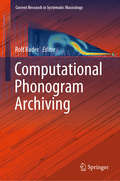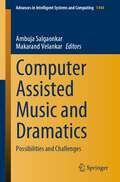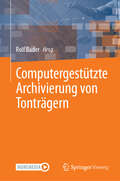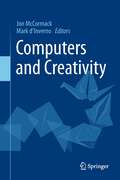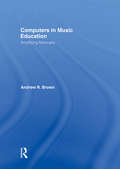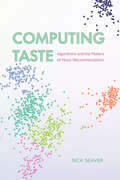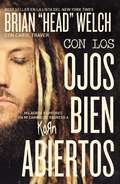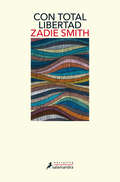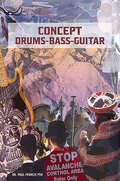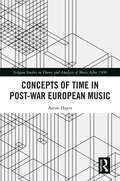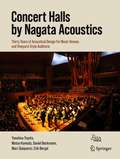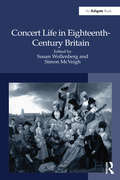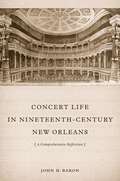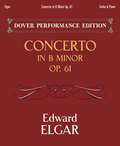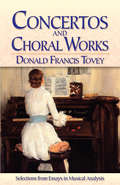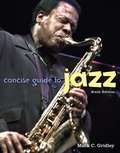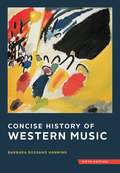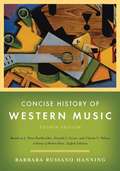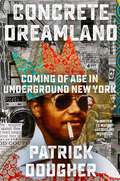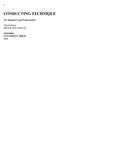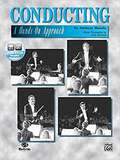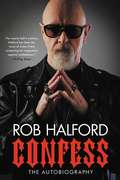- Table View
- List View
Computational Phonogram Archiving (Current Research in Systematic Musicology #5)
by Rolf BaderThe future of music archiving and search engines lies in deep learning and big data. Music information retrieval algorithms automatically analyze musical features like timbre, melody, rhythm or musical form, and artificial intelligence then sorts and relates these features. At the first International Symposium on Computational Ethnomusicological Archiving held on November 9 to 11, 2017 at the Institute of Systematic Musicology in Hamburg, Germany, a new Computational Phonogram Archiving standard was discussed as an interdisciplinary approach. Ethnomusicologists, music and computer scientists, systematic musicologists as well as music archivists, composers and musicians presented tools, methods and platforms and shared fieldwork and archiving experiences in the fields of musical acoustics, informatics, music theory as well as on music storage, reproduction and metadata. The Computational Phonogram Archiving standard is also in high demand in the music market as a search engine for music consumers. This book offers a comprehensive overview of the field written by leading researchers around the globe.
Computer Assisted Music and Dramatics: Possibilities and Challenges (Advances in Intelligent Systems and Computing #1444)
by Ambuja Salgaonkar Makarand VelankarThis book is intended for researchers interested in using computational methods and tools to engage with music, dance and theatre. The chapters have evolved out of presentations and deliberations at an international workshop entitled Computer Assisted Music and Dramatics: Possibilities and Challenges organized by University of Mumbai in honour of Professor Hari Sahasrabuddhe, a renowned educator and a pioneering computational musicologist (CM) of Indian classical music. The workshop included contributions from CM as well as musicians with a special focus on South Asian arts. The case studies and reflective essays here are based on analyses of genres, practices and theoretical constructs modelled computationally. They offer a balanced and complementary perspective to help innovation in the synthesis of music by extracting information from recorded performances. This material would be of interest to scholars of the sciences and humanities and facilitate exchanges and generation of ideas.
Computergestützte Archivierung von Tonträgern
by Rolf BaderDie Zukunft der Musikarchivierung und der Suchmaschinen liegt im Deep Learning und in Big Data. Algorithmen zum Abrufen von Musikinformationen analysieren automatisch musikalische Merkmale wie Klangfarbe, Melodie, Rhythmus oder musikalische Form, und künstliche Intelligenz sortiert und verknüpft diese Merkmale dann. Auf dem ersten International Symposium on Computational Ethnomusicological Archiving, das vom 9. bis 11. November 2017 am Institut für Systematische Musikwissenschaft in Hamburg stattfand, wurde ein neuer Standard für Computational Phonogram Archiving als interdisziplinärer Ansatz diskutiert. Ethnomusikologen, Musik- und Computerwissenschaftler, Systematische Musikwissenschaftler sowie Musikarchivare, Komponisten und Musiker stellten Werkzeuge, Methoden und Plattformen vor und tauschten Erfahrungen aus der Feldforschung und Archivierung in den Bereichen musikalische Akustik, Informatik, Musiktheorie sowie Musikspeicherung, -wiedergabe und Metadaten aus. Der Standard Computational Phonogram Archiving ist auch auf dem Musikmarkt als Suchmaschine für Musikkonsumenten sehr gefragt. Dieses Buch bietet einen umfassenden Überblick über das Gebiet, geschrieben von führenden Forschern aus aller Welt.
Computers and Creativity
by Jon Mccormack Mark D’invernoThis interdisciplinary volume introduces new theories and ideas on creativity from the perspectives of science and art. Featuring contributions from leading researchers, theorists and artists working in artificial intelligence, generative art, creative computing, music composition, and cybernetics, the book examines the relationship between computation and creativity from both analytic and practical perspectives. Each contributor describes innovative new ways creativity can be understood through, and inspired by, computers. The book tackles critical philosophical questions and discusses the major issues raised by computational creativity, including: whether a computer can exhibit creativity independently of its creator; what kinds of creativity are possible in light of our knowledge from computational simulation, artificial intelligence, evolutionary theory and information theory; and whether we can begin to automate the evaluation of aesthetics and creativity in silico. These important, often controversial questions are contextualised by current thinking in computational creative arts practice. Leading artistic practitioners discuss their approaches to working creatively with computational systems in a diverse array of media, including music, sound art, visual art, and interactivity. The volume also includes a comprehensive review of computational aesthetic evaluation and judgement research, alongside discussion and insights from pioneering artists working with computation as a creative medium over the last fifty years. A distinguishing feature of this volume is that it explains and grounds new theoretical ideas on creativity through practical applications and creative practice. Computers and Creativity will appeal to theorists, researchers in artificial intelligence, generative and evolutionary computing, practicing artists and musicians, students and any reader generally interested in understanding how computers can impact upon creativity. It bridges concepts from computer science, psychology, neuroscience, visual art, music and philosophy in an accessible way, illustrating how computers are fundamentally changing what we can imagine and create, and how we might shape the creativity of the future. Computers and Creativity will appeal to theorists, researchers in artificial intelligence, generative and evolutionary computing, practicing artists and musicians, students and any reader generally interested in understanding how computers can impact upon creativity. It bridges concepts from computer science, psychology, neuroscience, visual art, music and philosophy in an accessible way, illustrating how computers are fundamentally changing what we can imagine and create, and how we might shape the creativity of the future.
Computers in Music Education: Amplifying Musicality
by Andrew BrownComputers in Music Education addresses the question of how computer technologies might best assist music education. For current and preservice music teachers and designed as a development tool, reference resource, and basic teaching text, it addresses pedagogical issues and the use of computers to aid production and presentation of students’ musical works. Written by a music educator and digital media specialist, it cuts through the jargon to present a concise, easy-to-digest overview of the field, covering: notation software MIDI sound creation downloading music posting personal MP3s for mass distribution. While there are many more technical books, few offer a comprehensive, understandable overview of the field. Computers in Music Education is an important text for the growing number of courses in this area.
Computing Taste: Algorithms and the Makers of Music Recommendation
by Nick SeaverMeet the people who design the algorithms that capture our musical tastes. The people who make music recommender systems have lofty goals: they want to broaden listeners’ horizons and help obscure musicians find audiences, taking advantage of the enormous catalogs offered by companies like Spotify, Apple Music, and Pandora. But for their critics, recommender systems seem to embody all the potential harms of algorithms: they flatten culture into numbers, they normalize ever-broadening data collection, and they profile their users for commercial ends. Drawing on years of ethnographic fieldwork, anthropologist Nick Seaver describes how the makers of music recommendation navigate these tensions: how product managers understand their relationship with the users they want to help and to capture; how scientists conceive of listening itself as a kind of data processing; and how engineers imagine the geography of the world of music as a space they care for and control. Computing Taste rehumanizes the algorithmic systems that shape our world, drawing attention to the people who build and maintain them. In this vividly theorized book, Seaver brings the thinking of programmers into conversation with the discipline of anthropology, opening up the cultural world of computation in a wide-ranging exploration that travels from cosmology to calculation, myth to machine learning, and captivation to care.
Computing Taste: Algorithms and the Makers of Music Recommendation
by Nick SeaverMeet the people who design the algorithms that capture our musical tastes. The people who make music recommender systems have lofty goals: they want to broaden listeners’ horizons and help obscure musicians find audiences, taking advantage of the enormous catalogs offered by companies like Spotify, Apple Music, and Pandora. But for their critics, recommender systems seem to embody all the potential harms of algorithms: they flatten culture into numbers, they normalize ever-broadening data collection, and they profile their users for commercial ends. Drawing on years of ethnographic fieldwork, anthropologist Nick Seaver describes how the makers of music recommendation navigate these tensions: how product managers understand their relationship with the users they want to help and to capture; how scientists conceive of listening itself as a kind of data processing; and how engineers imagine the geography of the world of music as a space they care for and control. Computing Taste rehumanizes the algorithmic systems that shape our world, drawing attention to the people who build and maintain them. In this vividly theorized book, Seaver brings the thinking of programmers into conversation with the discipline of anthropology, opening up the cultural world of computation in a wide-ranging exploration that travels from cosmology to calculation, myth to machine learning, and captivation to care.
Computing Taste: Algorithms and the Makers of Music Recommendation
by Nick SeaverMeet the people who design the algorithms that capture our musical tastes. The people who make music recommender systems have lofty goals: they want to broaden listeners’ horizons and help obscure musicians find audiences, taking advantage of the enormous catalogs offered by companies like Spotify, Apple Music, and Pandora. But for their critics, recommender systems seem to embody all the potential harms of algorithms: they flatten culture into numbers, they normalize ever-broadening data collection, and they profile their users for commercial ends. Drawing on years of ethnographic fieldwork, anthropologist Nick Seaver describes how the makers of music recommendation navigate these tensions: how product managers understand their relationship with the users they want to help and to capture; how scientists conceive of listening itself as a kind of data processing; and how engineers imagine the geography of the world of music as a space they care for and control. Computing Taste rehumanizes the algorithmic systems that shape our world, drawing attention to the people who build and maintain them. In this vividly theorized book, Seaver brings the thinking of programmers into conversation with the discipline of anthropology, opening up the cultural world of computation in a wide-ranging exploration that travels from cosmology to calculation, myth to machine learning, and captivation to care.
Con los ojos bien abiertos: Milagros y errores en mi camino de regreso a KoRn
by Brian WelchTras darse cuenta de que estaba estropeando su vida, y peor aún, la de su hija Jennea, debido a sus excesos en las drogas, el alcohol y la fiesta salvaje, Brian "Head" Welch, guitarrista de la banda KoRn, experimentó un impresionante despertar espiritual que le cambió la vida y lo liberó de la subyugación que implican las sustancias tóxicas. Decidió abandonar en 2005 la exitosa banda que había fundado en 1993, para sanarse. Lo que vino a continuación fue una prueba de fuego que duró una década, desde las dificultades de ser padre de una adolescente extraviada en la depresión y la auto-mutilación, a la dura realidad de tocar solo y sobreponerse a la desgarradora traición de un amigo de toda su confianza. En esta inspiradora saga de redención, quizás la más vivificante sea la radical decisión de Brian de reintegrarse a KoRn y reconciliarse con esa tribu de personas a las que alguna vez consideró su familia, en el horizonte musical del metal. Brian volvió a sus raíces musicales con la cabeza clara y el corazón devoto. Aunque su historia es salvaje, hilarante y profundamente conmovedora, el mensaje es simple: Dios te amará en la libertad de ser tú mismo, siempre y cuando mantengas una relación viva con Él y nunca, nunca renuncies a ella.
Con total libertad
by Zadie SmithUn libro cargado de agudeza, frescura y empatía que nos ilumina en un mundo cada vez más cambiante y contradictorio. Zadie Smith ha demostrado ser una ensayista brillante y singular, haciendo que cada texto suyo sea un acontecimiento literario por derecho propio. Con total libertad, que recopila algunos de los más celebrados, abarca el amplísimo rango de intereses de Smith: desde todas las facetas de la cultura y la libertad artística hasta los temas más acuciantes de la política y la actualidad, siempre desde una perspectiva original y radicalmente personal. Gracias a su fina agudeza, una frescura contagiosa y una empatía extraordinaria, este libro es una guía imprescindible para entender un mundo, el nuestro, cada vez más complejo y contradictorio. La crítica ha dicho:«Ecléctica en sus gustos y centrífuga en su estilo, Zadie Smith disfruta, como articulista, de ampliar los límites de su pensamiento [...] En la línea de Hazlitt y Orwell, Woolf y Angela Carter.»The Financial Times «Interesante, sagaz [...]¿Se debe leer este libro brillante? ¡Por supuesto que sí!»The Independent «Un libro inteligente, ingenioso y a menudo hilarante que demuestra que (Zadie Smith) es una de las mentes más brillantes de la literatura británica de hoy en día.»NPR «Es un placer exquisito observar a Zadie Smith pensar a lo largo de estas páginas.»The New York Times Book Review «Smith lleva a la escritura de artículos sus dotes como novelista: buen ojo para el detalle, sutiles giros en las frases.»The Boston Globe «Estos ensayos en su conjunto reflejan una mente abierta, vivaz, natural, rigurosa, erudita y seria, ocupada en perfeccionar su manera de ver la vida, la literatura y la relación entre ambas. Smith demuestra que es mucho más que una cabeza adulta y comprensiva sobre unos hombros muy jóvenes. Y lo demuestra con su apasionada, compulsivamente dialéctica y atractiva indagación de la literatura».Los Angeles Times «No importa sobre lo que escriba -su padre, Kafka, Liberia, George Clooney-: colocar cualquier tema dentro del campo magnético de su cerebro incansable basta para volverlo fascinante. Smith [...] tiene el don de mostrarnos cómo lee y piensa; al ver cómo lo hace, uno se siente a su vez más inteligente y observador por ósmosis.»Time
Concept Drums – Bass – Guitar
by Dr Paul FrancisConcept Drums - Bass - Guitar For tomorrow’s music makers This book contains: • Performance and tuition repertoire for HIGHER INSTRUMENTAL POPULAR MUSIC EDUCATION (HIPME). If you fancy a challenge, then give it a go! • CONTEMPORARY GROOVES - Stretch your technical abilities • DOWNLOADABLE BACKING TRACKS - With notated scores • EDUCATIONAL THEORY – An insight into how we learn PLUG IN.... TURN UP THE VOLUME.... 1.2.... 1...2....3....4
Concepts of Time in Post-War European Music (Ashgate Studies in Theory and Analysis of Music After 1900)
by Aaron HayesConcepts of Time in Post-War European Music gives a historical and philosophical account of the discussions of the nature of time and music during the mid-twentieth century. The nature of time was a persistent topic among composers in Paris and Darmstadt in the decades after World War II, one which influenced their musical practice and historical relevance. Based on the author’s specialized knowledge of the relevant philosophical discourses, this volume offers a balanced critique of these composers' attempts at philosophizing about time. Touching on familiar topics such as Adorno’s philosophy of music, the writings of Boulez and Stockhausen, and Messiaen’s theology, this volume uncovers specific relationships among varied intellectual traditions that have not previously been described. Each chapter provides a philosophical explanation of specific problems that are relevant for interpreting the composer’s own essays or lectures, followed by a musical analysis of a piece of music which illustrates central theoretical concepts. This is a valuable study for scholars and researchers of music theory, music history, and the philosophy of music.
Concert Halls by Nagata Acoustics: Thirty Years of Acoustical Design for Music Venues and Vineyard-Style Auditoria
by Yasuhisa Toyota Motoo Komoda Daniel Beckmann Marc Quiquerez Erik BergalThis visually stunning and data rich text catalogs the design of 32 concert halls by world-renowned acoustician Yasuhisa Toyota and his team at Nagata Acoustics, the firm behind the celebrated Walt Disney Concert Hall, the Hamburg Elbphilharmonie, and numerous others. Alongside architectural drawings and photographs, commentary on the design process and challenges of each hall provides insight for the dedicated listener to appreciate a wide range of internationally beloved concert venues. Summarized acoustical and architectural data for each of the halls will provide valuable reference information to architects and acousticians alike. Following the project anthology is an overview of the history, development, and acoustical features of vineyard- and surround-style concert halls. A broader discussion of design philosophy reveals the methods by which Toyota has guided architects to create world renowned halls. These technical and general discussions give architects the foundation to design for the performing arts, and provide audiences a new insight and perspective to consider the next time they attend a concert.
Concert Life in Eighteenth-Century Britain
by Susan Wollenberg Simon McVeighIn recent years there has been a considerable revival of interest in music in eighteenth-century Britain. This interest has now expanded beyond the consideration of composers and their music to include the performing institutions of the period and their relationship to the wider social scene. The collection of essays presented here offers a portrayal of concert life in Britain that contributes greatly to the wider understanding of social and cultural life in the eighteenth century. Music was not merely a pastime but was irrevocably linked with its social, political and literary contexts. The perspectives of performers, organisers, patrons, audiences, publishers, copyists and consumers are considered here in relation to the concert experience. All of the essays taken together construct an understanding of musical communities and the origins of the modern concert system. This is achieved by focusing on the development of music societies; the promotion of musical events; the mobility and advancement of musicians; systems of patronage; the social status of musicians; the repertoire performed and published; the role of women pianists and the 'topography' of concerts. In this way, the book will not only appeal to music specialists, but also to social and cultural historians.
Concert Life in Nineteenth-Century New Orleans: A Comprehensive Reference
by John H. BaronDuring the nineteenth century, New Orleans thrived as the epicenter of classical music in America, outshining New York, Boston, and San Francisco before the Civil War and rivaling them thereafter. While other cities offered few if any operatic productions, New Orleans gained renown for its glorious opera seasons. Resident composers, performers, publishers, teachers, instrument makers, and dealers fed the public's voracious cultural appetite. Tourists came from across the United States to experience the city's thriving musical scene. Until now, no study has offered a thorough history of this exciting and momentous era in American musical performance history. John H. Baron's Concert Life in Nineteenth-Century New Orleans impressively fills that gap.Baron's exhaustively researched work details all aspects of New Orleans's nineteenth-century musical renditions, including the development of orchestras; the surrounding social, political, and economic conditions; and the individuals who collectively made the city a premier destination for world-class musicians. Baron includes a wide-ranging chronological discussion of nearly every documented concert that took place in the Crescent City in the 1800s, establishing Concert Life in Nineteenth-Century New Orleans as an indispensable reference volume.
Concert Piano Repertoire: A Manual of Solo Literature for Artists and Performers
by Albert FaurotListing of classical musical pieces written for the solo piano player
Concerto in B Minor Op. 61: with Separate Violin Part (Dover Chamber Music Scores Ser.)
by Edward ElgarOne of the most beloved pieces in the modern violin repertoire, the Concerto in B Minor is among Edward Elgar's longest orchestral compositions and one of the last of his works to achieve and retain popular success. This practice and performance edition contains a piano reduction and a separate violin part.Famed violinist Fritz Kreisler pronounced Elgar the greatest living composer, placing him "on an equal footing with my idols, Beethoven and Brahms. He is of the same aristocratic family. His invention, his orchestration, his harmony, his grandeur—it is wonderful. I wish Elgar would write something for the violin." A commission from the Royal Philharmonic Society helped fulfill Kreisler's wish, and the violinist performed the Concerto in B Minor at its 1910 debut, with Elgar conducting the London Symphony Orchestra.
Concertos and Choral Works: Selections from Essays in Musical Analysis
by Donald Francis ToveyDrawn from the well-known musicologist's celebrated Essays in Musical Analysis, this volume contains nearly all of the concertos in the standard repertoire, from Bach's concerto for two violins to Walton's concerto for viola. More than fifty selections include choral works with in-depth essays on Bach's Mass in B minor, Beethoven's Mass in D, Brahms's and Verdi's Requiems, Haydn's The Creation and The Seasons, and many other landmark works. Donald Francis Tovey's Essays in Musical Analysis ranks among the English language's most acclaimed works of musical criticism. Praised for their acuteness, common sense, clarity, and wit, they offer entertaining and instructive reading for anyone interested in the classical music repertoire.
Concise Guide to Jazz (6th Edition)
by Mark C. GridleyThe Concise Guide to Jazz provides an introduction to jazz that is as clear and accurate as Jazz Styles but without as much detail. It is a very useful guide for teachers and students.
Concise History Of Western Music
by Barbara Russano HanningBarbara Hanning's Concise History of Western Music offers students a manageable introduction to the forces that shaped music. Combining concision with the imaginative pedagogy that her text pioneered, Hanning focuses on an essential repertoire of 109 characteristic works--from the Middle Ages to the present--providing students with the cultural and historical context to illuminate the music and remember its significance.
Concise History of Western Music (Fourth Edition)
by Barbara Russano HanningBased on A History of Western Music, by J. Peter Burkholder, Donald Jay Grout, and Claude V. Palisca, Concise History of Western Music, Fourth Edition, offers authoritative coverage of the essential works and genres in Western music history. By setting musical events into a memorable historical and cultural context, Concise History of Western Music provides a history students will read and remember.
Concrete Dreamland: Coming of Age in Underground New York
by Patrick DougherFrom an award-winning artist who was featured in Humans of New York comes a bold personal narrative about overcoming family trauma, addiction, poverty—and forging a creative life in the greatest city in the world. Born in Brooklyn in 1963, Patrick Dougher grew up in some of the most turbulent and culturally impactful periods of NYC's history. Often neglected as a child by his parents—a father who struggled with alcohol addiction and an overworked mother who struggled to make ends meet—he learned to fend for himself. Now a renowned visual artist, musician, actor and writer, Dougher brings to the page his memories, struggles, personal revelations, and a life intimately tied to the realities of growing up Black and disenfranchised on the streets of one of the most remarkable cities in the world.Concrete Dreamland is tragic and triumphant, gritty and hard, poetic and outrageously funny. Told in Dougher's brutally raw and courageously honest voice, these stories act as snapshots of a life lived in extremes: from gangsters to God, street style to sexuality, to recovery from drug addiction and alcoholism. He tells of his adventures as a pre-hip hop &“hard rock' and an original Black punk rocker surviving during the dangerous days of the crack and AIDS epidemic in NYC, while also sharing tales of racism, homelessness, and his many brushes with fame and death. Audacious, unique, and moving, Concrete Dreamland is an unforgettable story of addiction, redemption, and life on the streets of a vanishing New York.
Conducting Technique: For Beginners And Professionals
by Brock McElheranThis book starts at the very beginning and ends with some remarkably profound insights on conductorial subtleties. An experienced conductor is one in whom detection, diagnosis, and remedy take place simultaneously; as he hears the error, he realizes where the fault lies and what to do about it. This book gives valuable hints about these three basic conductorial functions from the viewpoint of chorus and orchestra alike. McElheran leads the student toward mastery of the problems at hand, with firmness and gentle humour.
Conducting: A Hands-On Approach
by Anthony Maiello Jack BullockThis comprehensive text by Anthony Maiello on the art of conducting is designed to be hands on, user friendly, playable by any instrumentation, a step-by-step approach to baton technique, great for use with a wind, string or voice conducting class, and excellent as a refresher course for all conductors at all levels of ability. The 232-page book covers a variety of conducting issues and the included recording contains all the musical exercises in the book (there are more than 100).
Confess: The Autobiography
by Rob HalfordThe legendary frontman of Judas Priest, one of the most successful heavy metal bands of all time, celebrates five decades of heavy metal in this tell-all memoir.Most priests hear confessions. This one is making his.Rob Halford, front man of global iconic metal band Judas Priest, is a true "Metal God." Raised in Britain's hard-working, heavy industrial heartland, he and his music were forged in the Black Country. Confess, his full autobiography, is an unforgettable rock 'n' roll story-a journey from a Walsall council estate to musical fame via alcoholism, addiction, police cells, ill-fated sexual trysts, and bleak personal tragedy, through to rehab, coming out, redemption . . . and finding love.Now, he is telling his gospel truth.Told with Halford's trademark self-deprecating, deadpan Black Country humor, Confess is the story of an extraordinary five decades in the music industry. It is also the tale of unlikely encounters with everybody from Superman to Andy Warhol, Madonna, Jack Nicholson, and the Queen. More than anything else, it's a celebration of the fire and power of heavy metal. Rob Halford has decided to Confess. Because it's good for the soul.
